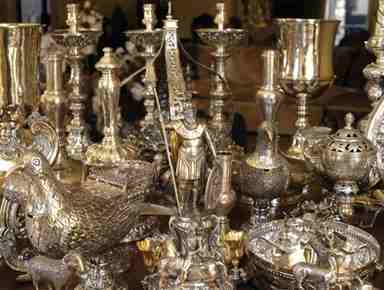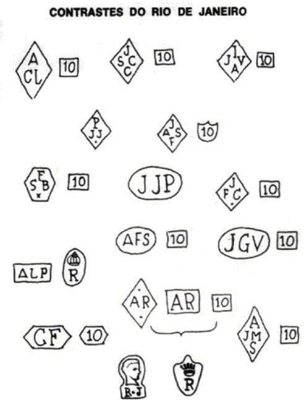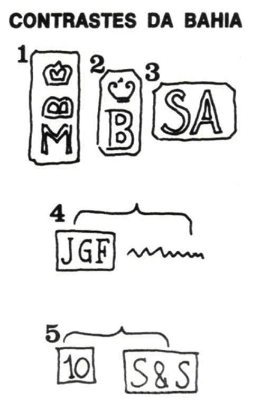|
(click on photos to enlarge image)
In the 19th century there was no official silver control in Brazil and silversmiths emulated hallmarks from Portugal, France and the UK to better sell their products. In fact the quality of the work was good but the public, apparently, preferred foreign hallmarks, even fake ones.
 1 1
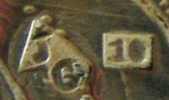 2 2
 3 3
 4 4

 5 5
1: Rio de Janeiro, maker Bennassi Bernard, c.1810 2: José Ferreira Guimaraes, c. 1850 3: Rio de Janeiro, unidentified maker 4: Rio de Janeiro, Francisco Duarte Graça, circa 1854 5: Rio de Janeiro, Francisco Duarte Graça, circa 1854 and pseudo Lisbon hallmark
SILVER MANUFACTURE IN BRAZIL
Since the beginning of colonization, silver has occupied an
important place in Brazilian society, being the preferred metal
for the decoration of homes and churches, but until the early
seventeenth century there is no record of the existence of
silverware made in Brazil. The settlers were engaged only in
exporting sugar, hardwoods, and spices to Portugal.
However, in general, as Brazil had no production of silver,
the metal came from the rich
mines of the Viceroyalty of Peru (which included
Bolivia) in the form of coins called "Macuquinas"
Macuquinas were coined in Spanish America (mainly in
Mexico and Peru) and are the oldest silver coins of
the continent.
In the period that Portugal and Spain had the same
government (1580 to 1640) bar of silver arrived in Brazil
across the Rio de la Plata.
After their separation, the "official" trade was
stopped and silver began to be introduced in Brazil
through the state of Mato Grosso in the form of
divisional currency. These coins were melted and the
raw material obtained was used in the manufacture of
silver objects.
As a consequence of this practice, the amount of
currency in circulation became so reduced that in 1693
the judge of the people in Bahia, Francisco Ribeiro
Velho, sent a request to the Prosecutor of the
Senate Chamber, arguing that silversmiths "ruin the
business in the Bahia". |
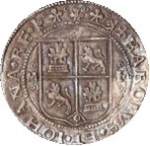
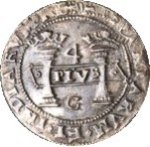
|
| |
Spanish America silver coins: Macuquinas
|
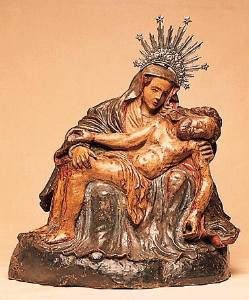 |
A further obstacle to the development of the art
of silversmithing in the country was the law that authorized
only gold/silversmiths of pure blood and devotees of Holy
Mother Church to execute liturgical objects,
excluding from the production any persons of mixed blood;
Jews, Africans and Asians.
Only in the eighteenth century, when the request for
silver liturgical objects increased greatly, did the gold/silversmiths
of impure blood, but with proven
ability, receive special permission to work the
silver.
Meanwhile, silver artifacts were punched with the
maker's mark of registered silversmiths and, during the time of the decree
banning the work in precious
metals, some pieces remained unmarked with the
addition of other illegal silver, made in the
prohibition era, from 1766 to 1815.
|
|
Our Lady of Mercy, 18th century: silver nimbus
|
|
A long series of goldsmiths' names are listed in the
Bahia guild's archives and books. Some may be highlighted
for their work: Joaquim Alberto da Conceição Matos,
Domingos de Sousa Marques, Boaventura de Andrade,
Manuel Eustáquio de Figueredo and many more.
It is documented that in 1683, 23 silversmiths were
active in Salvador. Less than one century later, in
1766, the workshops with several workers numbered more
than 158. |
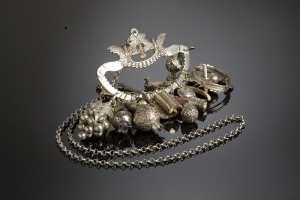 |
| |
24 elements, silver woman's ornament, Bahia, 19th century
|
The standard for silver marking follows the same regulation
as Portugal in the 15th and 16th century, but in Colonial Brazil only a
small amount of production was marked to avoid authorities' controls.
Silver manufactured in Bahia was marked with the "B crowned",
that of the Senate of Bahia with the "S" and that of Rio de
Janeiro with the "R crowned".
Also pieces can be found marked with "10" or bearing only the
silversmith's initials (especially in the 19th century).
In the 18th century, the independence of Brazil resulted in a great
development of jewellery manufacture in Rio de Janeiro.
During the reign of Emperor Dom Pedro II (1831-1889) silver objects began
to manifest some European influence.
The most common silver artifacts made in Brazil are candlesticks,
trays, vases, teapots, daggers, flatware, tea and coffee
services, salt cellars, dresser sets, inkwells, stirrups, crowns
of saints, monstrance, incensories, crosses of procession and
goblets .... with a prevalence of religious silver over that of
secular use.
What survives of the beautiful Colonial production can be
admired in the churches, museums and private collections.
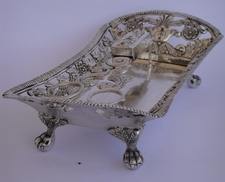
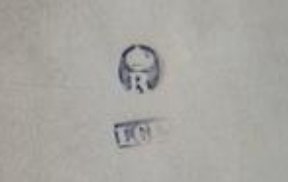
|
| Snuffer and tray: marks of Rio de Janeiro |
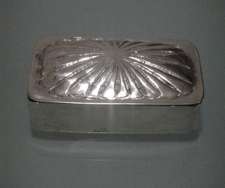
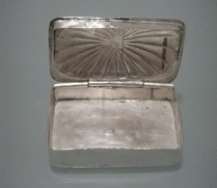
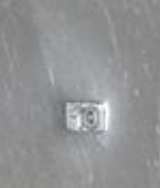
|
| Silver box: mark "10" (10 dinheiros) |
SILVER PLATE
In 1884, Angelo Fracalanza began his industrial
enterprise in Sao Paulo starting with the manufacture of
silver plate items.
Later, the firm began to produce house ware items,
reaching a high level of craftsmanship in the
production of flatware, tea and coffee services
in Alpaca metal |
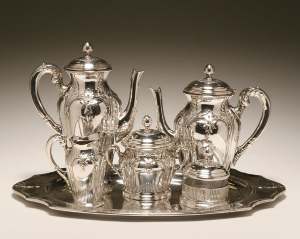

|
| |
Silver plate tea and coffee set made by Fracalanza |
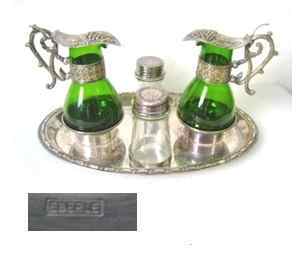
|
Another company involved in silver plate
production was Eberle. The firm began its activity
in 1896 as a small metallurgical factory. In 1918
the firm began to produce flatware, tea and coffee
services using the electroplating process. |
|
Silver plate cruet set made by Eberle |
|
A SELECTION OF BRAZILIAN SILVER
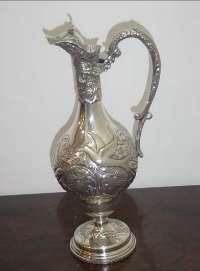
|
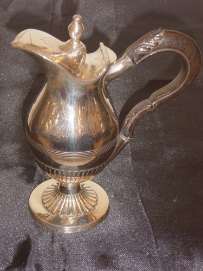
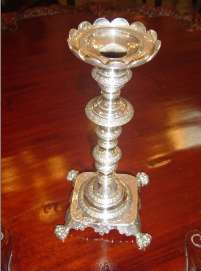 |
Vase, silver 800/1000:
Brazil 20th century |
Milk Jug: Brazil 18th century
Candlestick, mark "10" "R": Brazil 19th century |
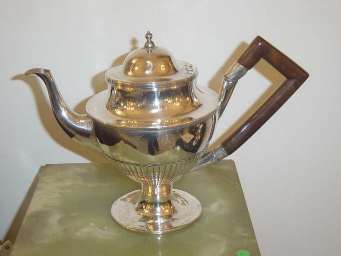 |
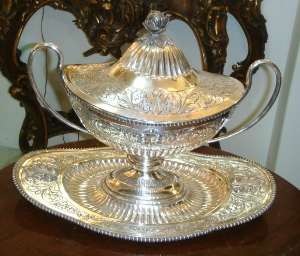 |
Teapot
Brazil 18th/19th century |
Oval tureen
Brazil 833/1000 silver |
 |
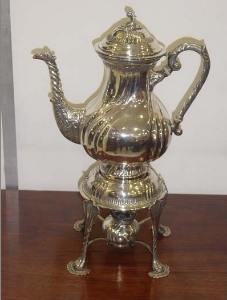 |
| Coconut:
Brazil 19th century |
Samovar, 800/1000 silver
Brazil 19th century |
photos Machado Antiques
REFERENCES
Dictionary of decorative arts and interior decoration de Rúbia
Braz Bueno do Prado / Ruth Rodrigo Octavio Londres / Stella
Rodrigo Octavio Moutinho - editor Nova Fronteira
Eberle - http://pt.wikipedia.org/wiki/Pr%C3%A9dios_da_Metal%C3%BArgica_Abramo_Eberle
Fracalanza Silver plate - http://www.fracalanza.com.br/frames.html
|

www.silvercollection.it |
This is a page of A Small Collection of
Antique Silver and Objects of vertu, a 1500 pages richly illustrated website offering all you need to know about
antique silver, sterling silver, silverplate, Sheffield plate, electroplate silver,
silverware, flatware, tea services and tea complements, marks and hallmarks, articles,
books, auction catalogs, famous silversmiths (Tiffany, Gorham, Jensen, Elkington),
history, oddities ...
HOME - SITE MAP - SILVER DICTIONARY - COOKIES CONSENT AND PRIVACY
OTHER ARTICLES ABOUT: ANTIQUE SILVER
SILVER PLATE
ENGLISH SILVER
FRENCH SILVER
|
|
|

 2
2
 3
3
 4
4

 5
5